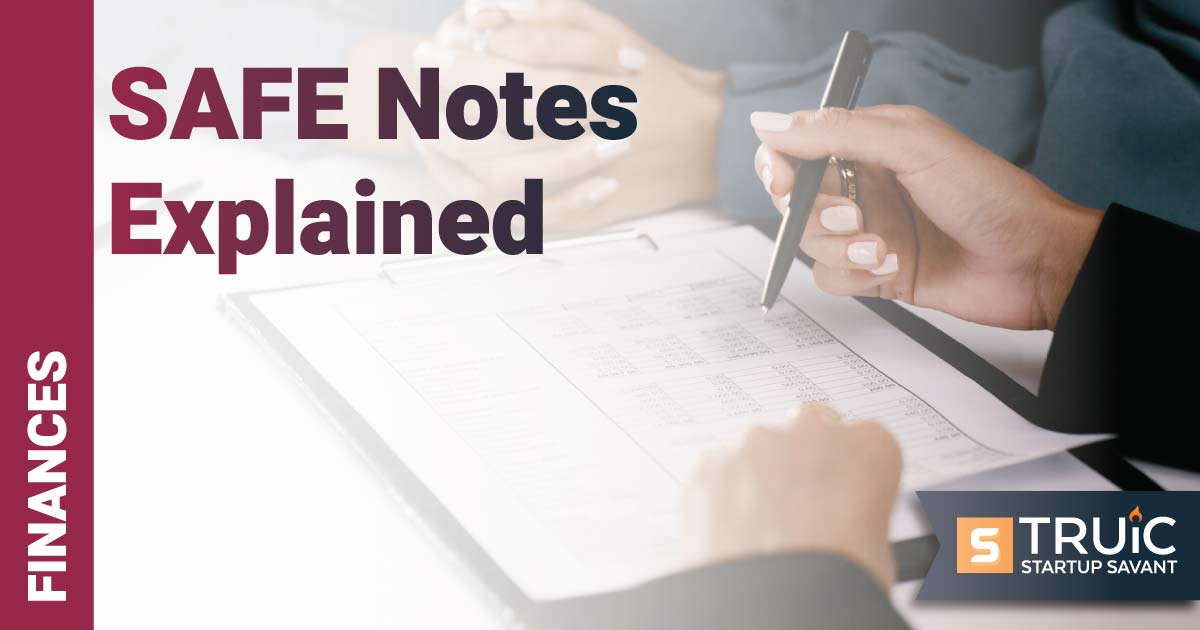SAFE Notes Explained

Last Updated: By Madison Holt
Securing funding is one of the most challenging parts of running a startup. SAFE Notes (Simple Agreement for Future Equity) are a relatively painless way for a founder to raise money. In this guide, we explain what SAFE notes are, their advantages and disadvantages, and legal and tax considerations.
What Is a SAFE Note?
A SAFE note is a type of convertible security that specifies a certain amount of money an investor will pay you as a business owner. In exchange, you agree to give the investor a certain amount of equity in your company at an agreed-upon future date.
In other words, a SAFE note confers the right for an investor to purchase shares in your company in a future-priced round.
How SAFE Notes Work
According to ContractsCounsel, a SAFE note works in the following way:
- An investor provides funding in exchange for the right to future equity.
- You use the funding to grow your business.
- After your company grows sufficiently, you secure another investor, and your company receives a “post-money valuation.”
- You calculate your company’s price per share.
- You convert the SAFE note into the applicable number of shares and distribute them to the SAFE investor. Typically, a SAFE note converts after an equity financing round.
Example of a SAFE Note
An investor purchases a SAFE note with a valuation cap of $20 million. During the next funding round, the value of your company is set at $40 million at $20 a share. Because the SAFE note has a valuation cap of $20 million, its owner can purchase twice as many shares of your company as new investors can. This was the incentive for the SAFE investor to provide funding earlier.
SAFE Note vs. Convertible Note
Both SAFE notes and convertible notes are ways for startups to secure early-stage funding, offering future equity to investors for money upfront. In addition, both SAFE notes and convertible notes convert into shares of preferred stock when a “triggering event” like a series A round occurs.
There are significant differences between SAFE notes and convertible notes. For example, SAFE notes:
- SAFE notes are not considered debt, whereas convertible notes are
- SAFE notes don’t have maturity dates, while convertible notes do
- SAFE notes don’t carry interest, while convertible notes do
- SAFE notes usually involve less paperwork than convertible notes
Advantages of SAFEs
Like all securities, SAFE notes have advantages and disadvantages. Here are some of the advantages, according to Indinero.
They’re Relatively Simple
As mentioned above, because SAFE notes typically don’t involve as much paperwork as convertible notes, they’re relatively easy to understand. For the same reason, you won’t spend as much on attorney’s fees as you will with a convertible note.
They’re Easier to Negotiate
For the same reason, it’s easier and cheaper to negotiate a SAFE note than a convertible note. There are fewer terms overall, and those terms can be more flexible than the terms of a convertible note. For example, they can be tailored to the desires of a specific investor.
They’re Easier on Founders
SAFE notes are easier for you to deal with as a founder. In particular, you don’t have to worry about deadlines and interest payments. Accounting is easier as well.
Drawbacks of SAFEs
SAFE notes also have disadvantages, including:
They Can Be Misleading
“SAFE notes can lead to an incorrect view of your company’s value in a future equity round,” indinero.com says. “In particular, a founder may think that the valuation cap contained in the SAFE note represents the potential future floor for an equity round. This may lead them to base their valuation projections for their company on this number.”
They Can Dilute Equity
“One of the most painful consequences of misusing or overusing SAFE notes is equity dilution,” indinero says.”The more shares early investors agree to purchase, the less of your company you eventually own when the notes convert. That means less control over your organization’s future. It also means you’ll have a harder time attracting Series A investors.”
SAFE Notes: Legal & Tax Considerations
Before issuing SAFE notes, it’s important to retain an attorney with appropriate experience so you don’t run afoul of securities laws. They can advise you on matters such as how SAFE notes are treated, how they are triggered, and what your legal rights and obligations are.
Both investors and startups should also retain an attorney to help them understand important tax considerations of SAFE notes, like the tax holding period.
“For a convertible note, that period will begin with its purchase,” UpCounsel says. “Upon the transformation of the note, the holding period will be retroactive, dating back to the time it had been issued. For SAFE notes, the process is similar, except that SAFE note holding periods will initiate once the note is used (that is, when it's ultimately converted into equity).”
Upcounsel also notes that SAFE notes can negatively affect an investor’s taxes. “If there's a non-cash sale of the company in which you invested or a sale that happens less than a year after you invested, you might lose out,” it says.
According to LegaMart, the tax treatment of SAFE notes for startups is unclear. Even so, SAFE notes and equity can be treated similarly for tax purposes because they both convert to equity at a later date. Again, retain an attorney to advise your startup on these matters.


